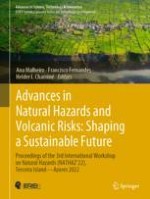2023 | OriginalPaper | Buchkapitel
The Functional Schematisation of the City as a Model for Anticipating Post-event Scenarios for Volcanic Hazards
verfasst von : Rafael Ramírez Eudave, Tiago Miguel Ferreira
Erschienen in: Advances in Natural Hazards and Volcanic Risks: Shaping a Sustainable Future
Verlag: Springer Nature Switzerland
Aktivieren Sie unsere intelligente Suche, um passende Fachinhalte oder Patente zu finden.
Wählen Sie Textabschnitte aus um mit Künstlicher Intelligenz passenden Patente zu finden. powered by
Markieren Sie Textabschnitte, um KI-gestützt weitere passende Inhalte zu finden. powered by
